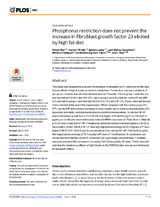Phosphorus restriction does not prevent the increase in fibroblast growth factor 23 elicited by high fat diet
Autor
Ríos, Rafael
Pineda Martos, Carmen María
López, Ignacio
Muñoz-Castañeda, Juan R.
Rodríguez, Mariano
Aguilera Tejero, Escolástico
Raya, Ana I.
Editor
Public Library of ScienceFecha
2018Materia
Mineral metabolismDiet
METS:
Mostrar el registro METSPREMIS:
Mostrar el registro PREMISMetadatos
Mostrar el registro completo del ítemResumen
This
study
was
designed
to evaluate
the
influence
of phosphorus
(P)
restriction
on
the
dele-
terious
effects
of high
fat
diets
on
mineral
metabolism.
Twenty-four
rats
were
allotted
to 3
groups
(n = 8 each)
that
were
fed
different
diets
for
7 months.
Rats
in group
1 were
fed
nor-
mal
fat-normal
P (0.6%)
diet
(NF-NP),
rats
in group
2 were
fed
high
fat-
normal
P diet
(HF-
NP)
and
rats
in group
3 were
fed
high
fat-low
P (0.2%)
diet
(HF-LP).
Blood,
urine
and
tissues
were
collected
at the
end
of the
experiments.
When
compared
with
the
control
group
(NF-
NP),
rats
fed
HF
diets
showed
increases
in body
weight,
and
in plasma
concentrations
of tri-
glycerides
and
leptin,
and
decreased
plasma
calcitriol
concentrations.
In rats
fed
HF-NP
plasma
fibroblast
growth
factor
23
(FGF23)
was
higher
(279.6
±
39.4
pg/ml
vs
160.6
±
25.0
pg/ml,
p = 0.018)
and
renal
klotho
(ratio
klotho/GAPDH)
was
lower
(0.75
±
0.06
vs
1.06
±
0.08,
p
<
0.01)
than
in rats
fed
NF-NP.
Phosphorus
restriction
did
not
normalize
plasma
FGF23
or
renal
klotho;
in fact,
rats
fed
HF-LP,
that
only
ingested
an
average
of 22.9
mg/day
of P,
had
higher
FGF23
(214.7
±
32.4
pg/ml)
concentratio
ns
than
rats
fed
NF-NP
(160.6
±
25.
0 pg/ml),
that
ingested
and
average
of 74.4
mg/day
of P over
a 7 month
period.
In conclusion,
our
results
demonstrate
that
severe
P restriction
over
a prolonged
period
of time
(7 months)
does
not
normalize
the
increase
in circulating
FGF23
induced
by
HF
diets.
These
data
indi-
cate
that
the
deleterious
effects
of high
fat
diet
on
the
FGF23/klotho
axis
are
not
eliminated
by
reduced
P intake.

